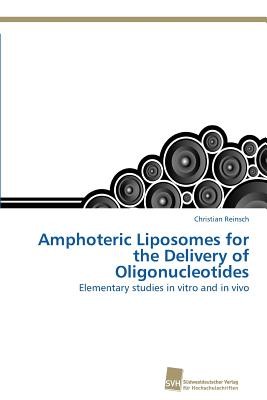
- We will send in 10–14 business days.
- Author: Christian Reinsch
- Publisher: Sudwestdeutscher Verlag Fur Hochschulschriften AG
- Year: 2013
- Pages: 112
- ISBN-10: 383813608X
- ISBN-13: 9783838136080
- Format: 15.2 x 22.9 x 0.7 cm, minkšti viršeliai
- Language: English
- SAVE -10% with code: EXTRA
Amphoteric Liposomes for the Delivery of Oligonucleotides (e-book) (used book) | bookbook.eu
Reviews
Description
The major objective of the present work was to provide an amphoteric liposomal composition well-described by biophysical and pharmacological analyses for the effective delivery of oligonucleotides in vitro and in vivo. Amphoteric liposomes contain lipids bearing pH-sensitive elements which sense the environmental pH. Under acidic conditions they become cationic and thus stably sequester nucleic acids. At physiological pH amphoteric liposomes are negatively charged and thus prevent the aggregation with anionic serum components during circulation. Optimized amphoteric liposomes provide a rational mechanism for the pH dependent fusion of the liposomal and endosomal membrane. They can therefore be used for the cytosolic delivery of oligonucleotides. Liposomes specifically address challenges involved with the transit of oligonucleotides into cells, namely biodistribution, cellular uptake and endosomal release, and are expected to unleash the full potential of oligonucleotide-based therapeutics.
EXTRA 10 % discount with code: EXTRA
The promotion ends in 22d.02:46:15
The discount code is valid when purchasing from 10 €. Discounts do not stack.
- Author: Christian Reinsch
- Publisher: Sudwestdeutscher Verlag Fur Hochschulschriften AG
- Year: 2013
- Pages: 112
- ISBN-10: 383813608X
- ISBN-13: 9783838136080
- Format: 15.2 x 22.9 x 0.7 cm, minkšti viršeliai
- Language: English English
The major objective of the present work was to provide an amphoteric liposomal composition well-described by biophysical and pharmacological analyses for the effective delivery of oligonucleotides in vitro and in vivo. Amphoteric liposomes contain lipids bearing pH-sensitive elements which sense the environmental pH. Under acidic conditions they become cationic and thus stably sequester nucleic acids. At physiological pH amphoteric liposomes are negatively charged and thus prevent the aggregation with anionic serum components during circulation. Optimized amphoteric liposomes provide a rational mechanism for the pH dependent fusion of the liposomal and endosomal membrane. They can therefore be used for the cytosolic delivery of oligonucleotides. Liposomes specifically address challenges involved with the transit of oligonucleotides into cells, namely biodistribution, cellular uptake and endosomal release, and are expected to unleash the full potential of oligonucleotide-based therapeutics.


Reviews